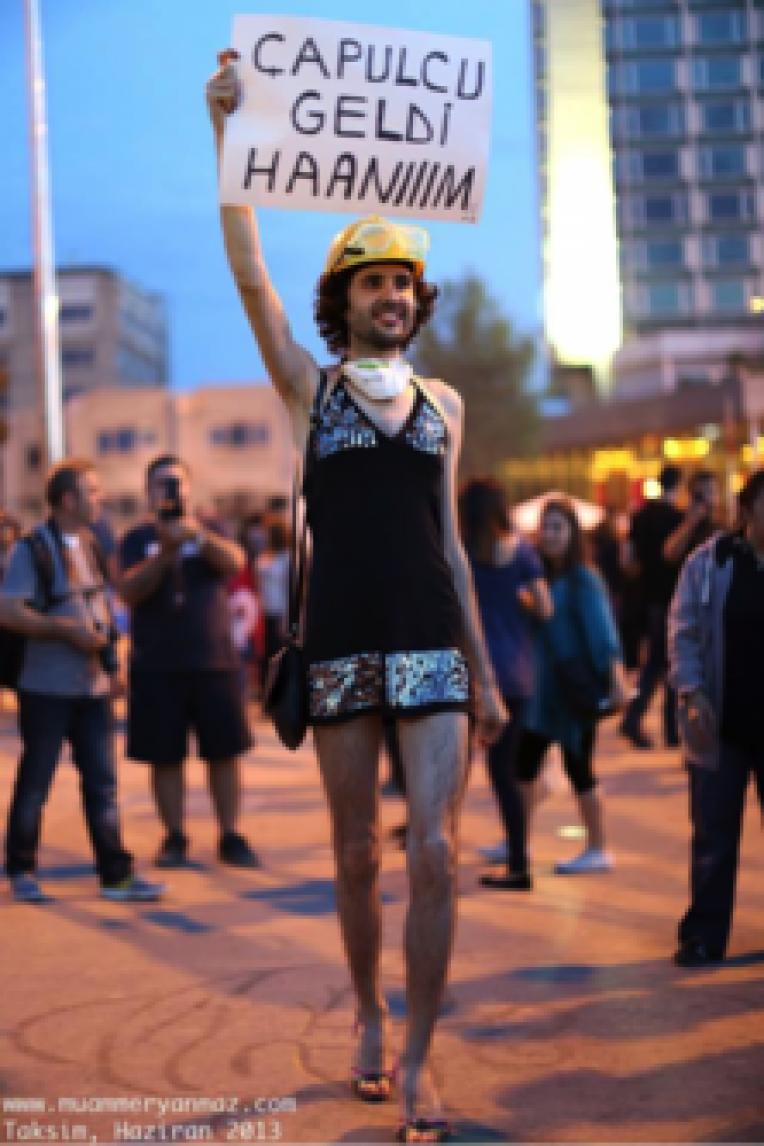What Is Queer about Gezi?
From the Series: An Impromptu Uprising: Ethnographic Reflections on the Gezi Park Protests in Turkey
From the Series: An Impromptu Uprising: Ethnographic Reflections on the Gezi Park Protests in Turkey

Near sunrise on May 31, 2013, the Istanbul police forcefully entered Gezi park, shattering and burning the tents and belongings of a few protestors who had occupied the park to stop it from being turned into a replica of an Ottoman garrison. The next day, thousands arrived at Gezi with indignation, initiating the process of Gezi’s emergence as a counter-public at both the national and international levels. It had gradually become a space for uncommon encounters between indefinite strangers, bodies, experiences, and discourses. Within this newly opened political space, queers of Istanbul became a major protest group, making the rainbow flag one of the most visible symbols of the movement.

Gezi had been a clandestine queer park famous for its blind hook-up spots. The majority of its visitors included gay men looking for casual sex, young rent boys under eighteen years old, and trans women selling inexpensive sexual services, as well as recent transgender and gay migrants to Istanbul seeking connections with other queers in the city. Equally important was the lower- or under-class status of the park as a site for the families of janitors residing in the basement apartments of the neighborhood and the financially deprived queers. Hence, when the park faced the threat of demolition for reasons similar to those that had recurrently displaced gays and trans women from neighborhoods such as Ülker Sokak, Tarlabaşı, and Harbiye—for instance, the prioritization of capital flow, public morality, and urban renewal aesthetics—LGBTQ people made the threat to queer livelihoods a significant site of struggle for the Gezi movement.
The remarkable queer presence and heightened visibility were engraved in the spaces of the uprising as queer people constructed barricades, held frontlines, and clashed with police. Queers painted seized bulldozers pink, waved the rainbow flag on top of barricades, pitched the “LGBT Blok” tent at the center of the park, and organized frequent drag-queen dances and small-group parades with slogans and songs. By painting over offensive graffiti, altering some swearword letters with the female symbol, and organizing an alternative “Swearword Workshop” (Küfür Atölyesi) to dispute the humiliation of women, gays, and sex workers, queers, together with feminists, challenged the misogynist, homophobic, and transphobic language of the resistance. In the intermixing of bodies, signs, objects, voices, stories, and emotions, Gezi solidarity renewed existing ties and spawned new intimacies and affections, giving its participants a “belonging in becoming” (Massumi 2002, 79). Soccer super-fans, for example, as the top users of the above-mentioned offensive language, presented their apologies and responded to the noted concerns by endeavoring to translate their political rage and passion into a more all-embracing language. Or when members of the so-called apolitical ‘90s generation were injured and took shelter from police violence in the houses of trans women sex workers, existing relations of transphobia were altered. Care, intimacy, and trust were coupled with realizations and confessions of homophobia/transphobia in the moments and spaces of the uprising. The intimate and affective ties that have emerged and grown between queer groups and other protestors have translated into outstanding attendance (approximately forty thousand) at this year’s Pride Parade on June 30, illustrating the support of non-queers in helping carry queer lives and words beyond the barricades.

Amid the temporary absence of the state within the barricaded Gezi zone, heterogeneity of visibilities and voices collectively exist, gaining radical and transformative potentials. The political and ethical conditions of seeing and hearing have “become otherwise.” The interruption of the state’s and mainstream publics’ roles in shaping “who is able to view whom, at what expense, and for what purpose” (Phillips 2005, 95) has shifted the sensorial conditionings of those who joined the movement within an affective and intimate economy of encounters, touches, and dialogues that have opened bodies and lives to new, unpredictable becomings. In that sense, Gezi has become about an “emergent relation, the becoming sensible in empirical conditions of mixture, of a modulation of potential becoming” (Massumi 2002, 77); namely, a queer becoming in togetherness that transgressed self-castigating sensations of anxiety and fear in the face of state violence.


Brian Massumi, Parables for the Virtual: Movement, Affect, Sensation, Durham, N.C.: Duke University Press, 2002.
David J. Phillips, "From Privacy to Visibility: Context, Identity, and Power in Ubiquitous Computing Environments," Social Text 23, no. 2 (2005): 95–108.